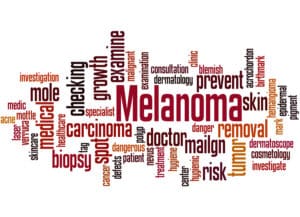 Melanoma is the most dangerous kind of skin cancer. It starts in the skin’s melanocytes, which are the cells that give skin its color. In addition to developing on the skin, melanoma can happen in the eyes and, rarely, in internal organs. The number of cases of melanoma has steadily risen in recent years. However, the death rate of the disease has only minimally decreased. Knowing more about melanoma and what to look for in your aging relative could result in earlier treatment of the disease, which could save their life.
Melanoma is the most dangerous kind of skin cancer. It starts in the skin’s melanocytes, which are the cells that give skin its color. In addition to developing on the skin, melanoma can happen in the eyes and, rarely, in internal organs. The number of cases of melanoma has steadily risen in recent years. However, the death rate of the disease has only minimally decreased. Knowing more about melanoma and what to look for in your aging relative could result in earlier treatment of the disease, which could save their life.
General Information About Melanoma
Melanoma happens when something goes wrong in the melanocytes. Normally, skin cells follow an orderly lifecycle. As new cells form, they shove the older cells up to the surface of the skin where they die and fall off. However, when DNA is damaged, it can cause new cells to grow out of control and create a cancerous mass.
Doctors don’t know what causes the changes that lead to cancer, but they have identified risk factors that increase the risk of melanoma, such as:
- Skin Color: Having fair skin increases the likelihood of developing melanoma. However, people with dark skin can also get skin cancer.
- Sunburn History: People who have suffered even one severe sunburn with blisters are at greater risk.
- UV Exposure: Exposure to ultraviolet (UV) radiation, such as the sun’s rays, makes people more likely to get melanoma.
- Family History: When a close family member, like a parent or sibling, who has had melanoma increases the chances for melanoma.
Weakened Immune System: People with weakened immune systems because of chronic illnesses or cancer treatment have a greater chance of developing skin cancer.
Symptoms of Melanoma
The main symptom to watch for is a new or changing spot on the skin or one that looks different from other spots on the skin. The American Cancer Society recommends using the ABCDE rule to spot signs of skin cancer. The ABCDE rule is:
- Asymmetry: One side of the spot does not match the other.
- Border: The edges, or border, of the spot are not regular in nature. They look ragged or blurry.
- Color: The spot is not uniform in color. Instead, it has different shades of brown, black, pink, red, white, or blue.
- Diameter: The spot is larger, bigger than a pencil eraser. However, melanoma can be smaller.
- Evolving: The spot is changing in color, size, or shape.
If your aging relative has been diagnosed with melanoma, senior care can assist them during treatment and recovery. Senior care providers can drive the older adult to their treatment appointments and for follow-up exams. Senior care providers can also care for the elderly person at home, helping them to manage side effects from chemotherapy or radiation.
Sources
https://www.webmd.com/melanoma-skin-cancer/news/20190507/as-melanoma-rises-doctors-challenge-some-early-testing
https://www.cancer.org/cancer/melanoma-skin-cancer/detection-diagnosis-staging/signs-and-symptoms.html
https://www.mayoclinic.org/diseases-conditions/melanoma/symptoms-causes/syc-20374884
If you or an aging loved one are considering senior care in Katy, TX, please call the caring staff at At Your Side Home Care. We will answer all of your senior care questions. Call today: (832) 271-1600.
Our Certified Nurse Aides, 24-Hour Live-in Assistants and Home Health Aides are available 24 hours a day, 365 days a year. We also provide the security and confidence of 24-hour Telephone Assistance, so fast, reliable help is always available when it's needed. To learn more about our homecare services see our homecare services page.
Different people need different levels of homecare. To meet the requirements of our clients, At Your Side Homecare maintains consistent staffing levels of caring professionals. Homecare service is available for as little as a few hours a week, or as many as 24 hours a day, seven days a week
- 5 Signs a Senior Might Be in the Beginning Stages of Dementia - April 25, 2025
- What Solutions Can Help Seniors with Mental Health Challenges? - April 18, 2025
- How Does Senior Home Care Help Make Aging in Place Possible? - April 11, 2025



